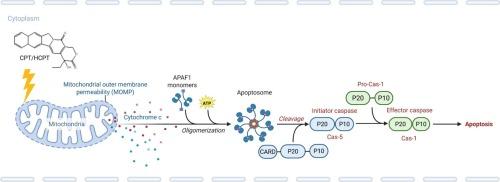Caspase cascade in the apoptosis induced by camptothein in IOZCAS-Spex-II cells
IF 4
1区 农林科学
Q2 BIOCHEMISTRY & MOLECULAR BIOLOGY
引用次数: 0
Abstract
Camptothecin (CPT) has been found to have insecticidal and fungicidal activities, and gives potential to be developed for use in agrochemicals. Our previous studies demonstrate that caspase-mediated intrinsic apoptotic pathways regulate CPT-induced apoptosis in Spodoptera exigua. However, the underlying mechanisms for caspase cascades remains unclear. In the present study, six caspases (Cas-1 to −6) were identified in IOZCAS-Spex-II cells derived from S. exigua fat bodies. Phylogenetic, biochemical, and immunoblot analyses confirmed a conserved Cas5-Cas1 cascade in apoptosis induced by CPT and its derivative hydroxycamptothecin (HCPT). Cas-5 functioned as the initiator caspase, showing early upregulation and autoactivation. Cas-1 acted as the executioner via proteolytic cleavage. Pre-treatment of cells with Z-VAD-FMK before CPT exposure significantly reduced cytotoxicity by 75.7 % at 48 h and 86.8 % at 72 h. Furthermore, the caspase activities, as well as the cleavage of Cas-1 and Cas-5 triggered by CPT, were effectively suppressed. Additionally, the relative mRNA expression analysis revealed that S. exigua caspases exhibited different responses between CPT and HCPT in IOZCAS-Spex-II cells. Beyond the Cas5-Cas1 cascade activation, HCPT treatment induced stronger upregulation of Cas-2, Cas-3, and Cas-6 compared to CPT treatment. These differential expression profiles suggested that HCPT may engage additional caspase cascade in IOZCAS-Spex-II cells. Given that S. exigua is a major agricultural pest, understanding these apoptotic pathways could reveal potential targets for pest control by disrupting its apoptotic regulation.

Caspase级联在喜树素诱导IOZCAS-Spex-II细胞凋亡中的作用
喜树碱(CPT)已被发现具有杀虫和杀真菌的活性,具有开发用于农用化学品的潜力。我们之前的研究表明,caspase介导的内在凋亡通路调节cpt诱导的夜蛾凋亡。然而,caspase级联的潜在机制尚不清楚。在本研究中,从S. exigua脂肪体中提取的IOZCAS-Spex-II细胞中鉴定出6个caspase (Cas-1至- 6)。系统发育、生化和免疫印迹分析证实,在CPT及其衍生物羟基喜树碱(HCPT)诱导的细胞凋亡中存在保守的Cas5-Cas1级联反应。caspase -5作为caspase的启动物,表现出早期上调和自激活。Cas-1通过蛋白水解裂解充当刽子手。在CPT暴露前用Z-VAD-FMK预处理细胞,在48小时和72小时显著降低了75.7%和86.8%的细胞毒性。此外,CPT触发的caspase活性以及cas1和cas5的裂解被有效抑制。此外,相对mRNA表达分析显示,在IOZCAS-Spex-II细胞中,S. exigua caspases在CPT和HCPT之间表现出不同的应答。除了Cas5-Cas1级联激活外,与CPT治疗相比,HCPT治疗诱导了更强的cas2、cas3和cas6的上调。这些差异表达谱表明,HCPT可能在IOZCAS-Spex-II细胞中参与额外的caspase级联。考虑到甜菜夜蛾是一种主要的农业害虫,了解这些凋亡途径可以通过破坏其凋亡调控来揭示害虫防治的潜在目标。
本文章由计算机程序翻译,如有差异,请以英文原文为准。
求助全文
约1分钟内获得全文
求助全文
来源期刊
CiteScore
7.00
自引率
8.50%
发文量
238
审稿时长
4.2 months
期刊介绍:
Pesticide Biochemistry and Physiology publishes original scientific articles pertaining to the mode of action of plant protection agents such as insecticides, fungicides, herbicides, and similar compounds, including nonlethal pest control agents, biosynthesis of pheromones, hormones, and plant resistance agents. Manuscripts may include a biochemical, physiological, or molecular study for an understanding of comparative toxicology or selective toxicity of both target and nontarget organisms. Particular interest will be given to studies on the molecular biology of pest control, toxicology, and pesticide resistance.
Research Areas Emphasized Include the Biochemistry and Physiology of:
• Comparative toxicity
• Mode of action
• Pathophysiology
• Plant growth regulators
• Resistance
• Other effects of pesticides on both parasites and hosts.

 求助内容:
求助内容: 应助结果提醒方式:
应助结果提醒方式:


